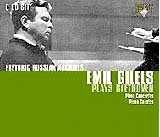Astute pianophiles may recognize some of the live performances gathered here from earlier CD incarnations on (among others) the Russian Revelation and Yedang labels. On the whole they reveal Emil Gilels to be a more interesting, three-dimensional, and dynamic Beethoven interpreter with an audience present than in front of studio microphones. This surely is the case with the five concertos, recorded during two concerts in December, 1976, where the pianist’s flexible phrasing and powerful projection surpass his less enlivening, more carefully executed 1968 studio counterparts under George Szell. Granted, Gilels’ imposing sonority turns harsh and pounding during the “Emperor” concerto’s climaxes, yet he replicates the pearly, disembodied legato phrasing in the slow movement that draws me back to his great 1958 stereo version with Leopold Ludwig and the Philharmonia Orchestra (Testament).
Likewise, the live sonata performances generally outdo Gilels’ studio efforts for DG. Note the Op. 26 “Funeral March” sonata’s superior tonal heft and wider range of articulations and a G major Op. 31 No. 1 that’s freer and more spontaneous than its relatively tense and foursquare studio rival. The 1984 Hammerklavier (familiar from its previous appearance in the BMG/Melodiya Gilels boxed set) replicates the studio version’s measured tread, with 20 times the power, resonance, and cumulative sweep. The wrong notes don’t matter. While the three “name” sonatas (Moonlight, Pathétique, and Appassionata) are more animated and generous in character than the DG recordings, their poor, mangy sonics are hard to take. But the remaining items sound excellent for archival recordings of their vintage. If you haven’t warmed to Gilels’ Beethoven in the past, this collection may change your mind.
































